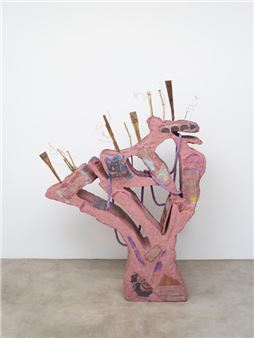Detanico Lain: 27 rue de Fleurus
In the series 27 rue de Fleurus, Angela Detanico and Rafael Lain used the
CГәbica [Cubic] system, developed by them, to rewrite poems from the book Tender
Buttons, by Gertrude Stein. The artists then applied chromatic splotches to the
compositions based on paintings in the art collection of Stein, whose residence
was located at 27 Fleurus street, in Paris.
Gertrude SteinвҖҷs prose arose, in the early 20th century, based on a dense
dialogue with the cubism of CГ©zanne and Picasso вҖ“ two of the artists who were
most present in her collection. As critic James R. Mellow once wrote, вҖңThe Stein
residence in Paris was a Mecca for the modern- minded. The principal attraction
was the collection of CГ©zanne oils and watercolors, the early pictures by
Matisse and Picasso, the paintings by Renoir, Manet, Gauguin and
Toulouse-Lautrec, which she and Leo [her brother] had had the funds and the
foresight to buy. The walls of their atelier were hung to the ceiling with
now-famous paintings, the double doors of the dining room were lined with
Picasso sketches. In the early decades of the century, hundreds of visitors
flocked to the display of vanguard art: many came to scoff, but several went
away converted. It was a brilliant scene вҖ“ and a historic one. For all intents
and purposes, Leo and Gertrude Stein had inaugurated, at 27 rue de Fleurus, the
first museum of modern art.вҖқ
Angela Detanico and Rafal Lain have been developing a series of alphabets
since the early 2000s, which take the hybridism between design and art they deal
with in their production and ally this with traditions such as concrete poetry,
which sought to give form to the word. This production also involves a game with
contemporary art itself; as stated by critic and curator Lisette Lagnado: вҖңwhat
is not usually pedagogical is to stimulate the desire for the вҖҳact of
decipheringвҖҷ; it is to shift the traditional signifier/signified relation; and,
moreover, to offer a way to think about a reality for art in which the publicвҖҷs
(mental) participation is of greatest importance in order for the work not to
founder in an empty and tautological way.вҖқ

Recommended for you
In the series 27 rue de Fleurus, Angela Detanico and Rafael Lain used the
CГәbica [Cubic] system, developed by them, to rewrite poems from the book Tender
Buttons, by Gertrude Stein. The artists then applied chromatic splotches to the
compositions based on paintings in the art collection of Stein, whose residence
was located at 27 Fleurus street, in Paris.
Gertrude SteinвҖҷs prose arose, in the early 20th century, based on a dense
dialogue with the cubism of CГ©zanne and Picasso вҖ“ two of the artists who were
most present in her collection. As critic James R. Mellow once wrote, вҖңThe Stein
residence in Paris was a Mecca for the modern- minded. The principal attraction
was the collection of CГ©zanne oils and watercolors, the early pictures by
Matisse and Picasso, the paintings by Renoir, Manet, Gauguin and
Toulouse-Lautrec, which she and Leo [her brother] had had the funds and the
foresight to buy. The walls of their atelier were hung to the ceiling with
now-famous paintings, the double doors of the dining room were lined with
Picasso sketches. In the early decades of the century, hundreds of visitors
flocked to the display of vanguard art: many came to scoff, but several went
away converted. It was a brilliant scene вҖ“ and a historic one. For all intents
and purposes, Leo and Gertrude Stein had inaugurated, at 27 rue de Fleurus, the
first museum of modern art.вҖқ
Angela Detanico and Rafal Lain have been developing a series of alphabets
since the early 2000s, which take the hybridism between design and art they deal
with in their production and ally this with traditions such as concrete poetry,
which sought to give form to the word. This production also involves a game with
contemporary art itself; as stated by critic and curator Lisette Lagnado: вҖңwhat
is not usually pedagogical is to stimulate the desire for the вҖҳact of
decipheringвҖҷ; it is to shift the traditional signifier/signified relation; and,
moreover, to offer a way to think about a reality for art in which the publicвҖҷs
(mental) participation is of greatest importance in order for the work not to
founder in an empty and tautological way.вҖқ











